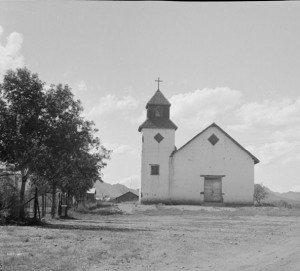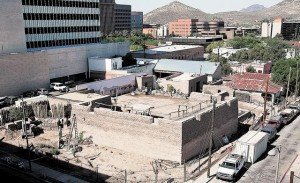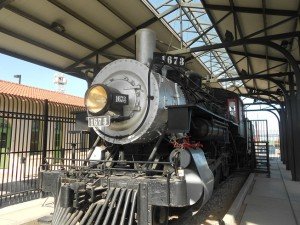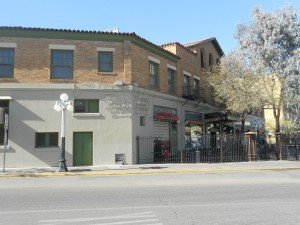El Presisio San Augustin del Tucson
At one time a Papago Indian village stood where present day Tucson is. The first Jesuit priest visited the Tucson area in 1692 and the Franciscans followed after that.
In 1775 the Spanish built El Presidio San Augustin del Tucson to help solidify their claim to the northern frontier of New Spain. One positive reason for the selection of Tucson as a garrison site was provided by the Native Americans themselves.

The Spanish first built the Tubac Presidio, about forty miles south of Tucson in 1751. This was following an Indian rebellion in which Tubac was razed and most of its inhabitants slain.
When the Spaniards built their missions along the California coast northward from San Diego in 1769, there was a need for protection for an overland route to frontier California from Sonora. Because of this the Spaniards ordered the garrison at the Tubac Presidio transferred northward to the new presidio in Tucson. The Tucson Presidio would be built along the Santa Cruz River across from Pimam Tucson.

Visiting St. Anns Church
While St. Anns Church is in Tubac Arizona, just a short drive south of Tucson, it is worth adding it to your Tucson trip planner. Along with it’s deep Spanish history, today, Tubac is a growing art community and offers fine resorts, shopping and dining.
A guided walking tour map of Tubac is available from any of the town merchants and at the Tubac Presidio State Historic Park.
St. Ann’s Church, which stands on Calle Iglesia near Placita de Anza in Tubac, is a relatively modern reminder of the presence of the Catholic Church in the area for most of 250 years.
Construction of a new church on the site of the original churches was begun in 1910 after parishioners mounted a fund drive, and St. Ann’s Church was completed in 1912.

Building El Presidio San Augustin del Tucson
The social structure of the entirety of colonial Spanish America had been built around a base of food-producing Native Americans. In fact one big reason why the site for the new presidio in Tucson was chosen was because of the close proximity of the Indians.
Defense officials could rely, they assumed, upon the Native American gardens at Tucson providing the garrison with at least some of its food needs. The site also offered adequate pasturage and firewood resources.
The new Tucson garrison was responsible with building the presidio. Tucson garrison at first lived on an open post. A typically defensive fort was not built immediately at the new location, even though some Apache bands had been stealing horses and raiding and killing settlers near Spanish outposts to the east since 1773.
The first actual fortifications erected apparently consisted of a wooden palisade. Some of the houses of citizens and soldiers were outside the palisade. Eventually an earthen defensive wall surrounded the military post, although some members of the garrison and civilians still lived in houses outside the wall.

The El Presidio Historic District
As one of the oldest continually inhabited areas in the country, Downtown Tucson has no shortage of history. Located downtown at Washington and Church Shttps://tripsintohistory.com/wp-admin/post.php?post=10483&action=edit&message=10treets, the Presidio San Agustín del Tucson is a re-creation of the northeast corner of the original 1775 Spanish presidio.
The walls of the Presidio were said to have run along Washington Street on the north, Church Street on the east, Pennington Street on the south, and Main Avenue on the west. Each wall was reported to be approximately 750 feet long.
The El Presidio Historic District is a residential neighborhood containing adobe and brick buildings in the Spanish-Mexican, Anglo-American and Eclectic architectural styles. The district is on the site of a prehistoric Hohokam Indian site and the original presidio. The Tucson Presidio Trust hosts Living History Festivals, October through April, where visitors can sample Spanish colonial food, listen to stories of old Tucson, learn period crafts and see musket and cannon fire.
The El Presidio Historic District is located north of West Alameda Street and west of North Church Street.

Tucson and the Southern Pacific Railroad
There’s one thing about Tucson Arizona that differentiates it from many of the other towns in southern Arizona and New Mexico. While the Southern Pacific Railroad certainly added to the growth of Tucson, the difference is that Tucson was a key settlement long before the arrival of the railroad.
Where some Arizona towns grew in direct relationship with the Southern Pacific Railroad, the story of Tucson, as explained above has all to do with the Spanish fort on 1775. Also, one time during the American Civil War Tucson served as the capital of the Confederates western Arizona region.

The Old Tucson Studios
This is a site you want to be sure to visit when in Tucson Arizona. The Old Tucson Studios is a replica of an old western town that was built in 1939 for the movie “Arizona”. The studios have also been used for many western movies and TV films. The studios offer visitors stage coach rides as well as rides on a narrow gauge railroad.
Also see the staged old west gunfights and stunt performances. Also see Old Tucson’s very own “silent” movie star, The Reno locomotive. The locomotive is stationed at the north end of Old Town Tucson. The Reno has more than 100 film and television credits. From Interstate 10 exit at Speedway Blvd and head west following signs to Old Tucson. From Interstate 19 exit at Ajo Way (AZ 86) and head west following signs to Old Tucson Studios.
See the Trips Into History articles on the links below…
A Visit to Fort Apache Historic Park
Drive the Los Caminos Antiguos Scenic Byway
The Southern Arizona Transportation Museum
The Southern Arizona Transportation Museum is also located in Old Town Tucson adjacent to the train station. The museum address is 414 N. Toole Ave. Tucson, AZ. Here you can explore much of the town’s railroad history regarding the Southern Pacific Railroad.

Outside of this Old Town Tucson museum is the famous Southern Pacific Railroad locomotive #1673. Southern Pacific locomotive #1673 is one of 105 of its type originally numbered 1615-1719. During it’s operation on the Southern Pacific it traveled over one million miles, primarily in freight service in the Southern Arizona region.
The locomotive was built by Schenectady Locomotive Works in New York in the year 1900. The SP locomotive #1673 was retired in 1955 and donated to the city of Tucson. In December of 2000, the old engine and tender were brought home to the historic Southern Pacific depot in downtown Old Town Tucson.
Hotel Congress
Now here is an old hotel with quite a history. The Hotel Congress, located in Old Town Tucson and across the street from the Tucson train station, in itself is a living piece of Tucson history.

The Hotel Congress is a historic building located in downtown Tucson and built in 1919.
The train station directly across the street at the rear of the hotel. The Hotel Congress building was added to the National Historic Register in 2003. The hotel is a valuable part of the Old Tucson community.
The Hotel Congress is conveniently located downtown and is extremely well restored right down to the rotary dial phones in the rooms. The Hotel Congress is also home to a Tap Room, the music venue Club Congress and an excellent restaurant. Club Congress is a music venue attached to the historic hotel. The music venue was opened in 1985. You’ll also find a great patio for food and beverages and it’s a good place to people watch.
(Article copyright 2014 Trips Into History. Photos of Congress Hotel, Southern Arizona Transportation Museum and Southern Pacific Steam Locomotive from Trips Into History Collection. Remainder of photos and images in the public domain.)
